List of natural monuments in the Dornbirn district
The list of natural monuments in the Dornbirn district lists the objects designated as natural monuments in the Dornbirn district in the state of Vorarlberg .
Natural monuments
| photo | Surname | ID | Location | description
|
surface | date |
|---|---|---|---|---|---|---|
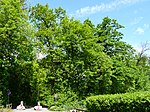
|
Oak group (Dornbirnerach-Au) | 3 |
Dornbirn location |
No accompanying board: Dornbirnerach-Au oak group (Quercus robur)
These oaks stand at the upper end of the right bank of the alluvial forest in the Dornbirn district of Rohrbach as typical forest edge trees and welcome walkers who are looking for relaxation. Traditional agriculture valued the oak not only as a source of shade, but its acorns were also important for the pig pasture and the leaves for the bedding for domestic animals. That is why there are still numerous solitary oaks in the Rhine Valley. |
||

|
Sequoia in Schillerstrasse | 7th |
Dornbirn location |
Blackboard text: Natural monument sequoia (Sequoiadendron giganteum)
The species comes from the forests of California, where these evergreen plants can grow up to 100 m high and over 3000 years old. At the turn of the century, sequoias were preferred to be planted as park trees. |
||

|
Linden tree on the town hall square | 8th |
Dornbirn location |
Blackboard text: Natural monument lime tree (Tilia sp.)
Mighty tree shape that characterizes the townscape. Linden trees can be up to 40 m high and over 2000 years old. You can find them in sunny places in damp valleys, but also in forests in the company of other deciduous trees, in settlements and as avenue trees. As here, the linden tree often adorns parks and village squares. [The board contains a small graphic: leaves and fruits] |
||

|
Giant Tree of Life (Ulmer Brothers) | 9 |
Dornbirn location |
Blackboard text: Natural monument, false cypress (Chamaecyparis lawsoniana)
22 m high exotic from southern North America, also known as white cedar. Like the tree of life (thuja), this species is often seen as a cut hedge. |
||

|
Tree-shaped juniper (Ammenegg) | 10 |
Dornbirn location |
Blackboard text: Natural monument juniper tree (Juniperus communis)
These undemanding, but very light-needing plants almost always grow shrub-like. Juniper only takes on the shape of a tree, as is the case here, with special care, but often through browsing by grazing cattle. Therefore, this 300-year-old tree is probably a witness to an older form of cultivation (forest pasture) on the area that is now a hay meadow. [The board contains a small graphic: leaves and fruits] |
||
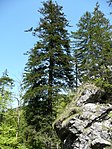
|
Silver fir in the Gütle | 11 |
Dornbirn location |
Text panel: Natural monument silver fir (Abies alba)
With a height of currently 46 m and a trunk circumference of 4.5 m, this fir is probably one of the most impressive in the municipality of Dornbirn. In the best conditions, silver firs can live for several hundred years, but they are usually used much earlier. This fir tree also increases in height and size year after year. [The board contains a small graphic: leaves and fruits] |
||

|
Sequoia in the Gütle | 34 |
Dornbirn location |
No accompanying panel: Sequoia in Gütle (Sequoiadendron giganteum)
The tree at the entrance to the Rappenloch Gorge was planted around 100 years ago and today (2012) is 55.5 m high and 7.15 m in circumference at 1.3 m above natural ground level. At that time it was fashionable to plant exotic trees in settlements and urban areas, but only a few of them have survived. |
||

|
Lärchenhain, Kehlegg cattle pasture | 35 |
Dornbirn location |
No accompanying board: Lärchenhain , Kehlegg cattle pasture
This strikingly scenic appearance of a group of larches with two stately black pines was included in the natural monument book of the Dornbirn district administration in 1978. Located in the middle of the Kehlegg cattle pasture, the group contains, in addition to larches and pines, some spruce trees and a large beech tree . The undergrowth with bracken and the rather wet cattle pasture with sour grasses and rushes are striking . |
||
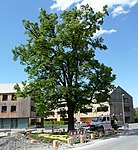
|
Linde rear Achmühle | 127 |
Dornbirn location |
Board text: Natural monument Achmühler Linde (Tilia sp.)
The linden tree dominating the space near the Achmühler Brunnen has the character of a village linden tree . In the past, gatherings, weddings and celebrations of all kinds took place under village or Brunnenlinden trees. With a height of 21 m and a trunk circumference of 2.15 m, the beautiful linden tree with the neighboring fountain and the adjoining houses effectively keep a piece of Alt-Dornbirn alive. [Modification, removal or destruction of this natural monument is only permitted with the approval of the authorities.] |
||

|
Pedunculate oak box lengths | 142 |
Dornbirn location |
No accompanying panel: English oak box length (Quercus robur)
In addition to the Kastenlangen residential complex, a particularly impressive oak was placed under protection in 1978. This solitary tree with a crown diameter of 18 m, 3 m trunk circumference and an age of 100 years is a remnant of the earlier natural reed landscape. The oak can be seen as a successful example of how valuable trees can be included in the design of the settlement. |
||

|
Two yew trees on Marktstrasse | 167 |
Dornbirn location |
Blackboard text: Natural monument yew trees (Taxus baccata)
Particularly strong specimens, typical park trees, which of all native trees can probably reach the highest age at over 2000 years. The needle-shaped leaves are very poisonous, the red seeds are eaten by birds, which in this way also ensure the spread. [The board contains a small graphic: leaves and fruits] |
||
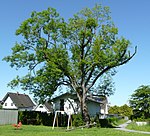
|
Ash on Druckergasse | 181 |
Dornbirn location |
Blackboard text: Natural monument ash (Fraxinus excelsior)
With a crown diameter of 25 m and a height of over 20 m, the natural monument on Druckergasse is a striking eye-catcher. Individual trees of this size are rare in the settlement area and therefore particularly worth preserving. Ash trees are usually tall, up to 40 m tall and 200-300 years old. [Modification, removal or destruction of this natural monument is only permitted with the approval of the authorities.] |
||

|
Hornbeam (Häfenberg) | 183 |
Dornbirn location |
No accompanying panel : Hornbeam Häfenberg (Carpinus betulus)
Not far from the old group of houses on the Häfenberg below Watzenegg above Dornbirn there is a hornbeam, also known as white beech, which is certainly more than 150 years old, with a trunk circumference of 2.5 m and a height of 17 m between a narrow hiking trail and the steep slope to the Steinebachtobel. Since hornbeams rarely get higher than 20 m, this is a huge specimen. |
||
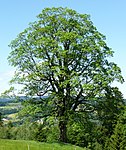
|
Sycamore Ammenegg | 184 |
Dornbirn location |
No accompanying table: Sycamore Ammenegg (Acer pseudoplatanus) | ||

|
Linden tree in front of the town hall | 217 |
Dornbirn location |
No accompanying board | ||
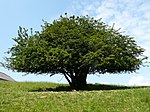
|
Hawthorn shrub Alpe Schuttannen | 12 |
Hohenems location |
No accompanying board: Hawthorn natural monument on the Schuttannen Alpe (Crataegus)
This extraordinarily large and very old hawthorn bush grows on the Alpe Schuttannen, north of the Ruhes Hut. Many individual trunks of the shrub seem to have grown together to form a single trunk. Only beyond the reach of the grazing cattle do the branches unfold into a small "treetop". The hawthorn not only shapes the landscape with its very special shape, it is also one of the largest wild-growing hawthorn bushes in the entire Rhine valley. |
2000 | |

|
Schillerallee | 13 |
Hohenems location |
Board text: Schillerallee natural monument
The Schillerallee consists of approx. 200 trees and is approx. 100 years old. It was planted on the flood protection of the Emsbach, the "Dämmle", which was built in the last century and led far out into the then uninhabited Rhine valley. The avenue consists mainly of linden trees in the eastern area. This section also represents the longest avenue of lime trees in the country. In the lower area there are mainly ash and willow species . Various other tree species are also occasionally planted. The Schillerallee has its special charm in every season. [town of Hohenems ] |
2000 | |
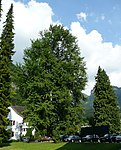
|
Ginkgo tree by the town hall | 14th |
Hohenems location |
Blackboard text: Ginkgo natural monument (Ginkgo biloba)
The phylogenetic tree of the ginkgo tree is much older than our deciduous trees and was spread around the world 190 million years ago. Nowadays it only occurs naturally in a small part of China, but is important as a park tree like here in front of the former count's guest house. This tree is estimated to be around 150 years old. On closer inspection, it becomes apparent that no two sheets are alike. Extensive healing effects are attributed to the ginkgo; No wonder then that it is venerated as a sacred tree in its Far Eastern homeland. [Stadt Hohenems ] [The board contains a small graphic: a ginkgo leaf] |
2000 | |
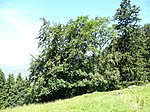
|
three sycamores near the Alpe Ranzenberg | 15th |
Hohenems location |
No accompanying board: Natural monuments Three sycamore maples (Acer pseudoplatanus) on Alpe Ranzenberg
The three old sycamore maples on the alpine hill of Alpe Ranzenberg are a fine example of the large old maples that were typically found on alpine areas in the past. Sycamore maples are common in our mountain forests. However, they only develop into such imposing trees as those on the Ranzenberg as free-standing specimens. They dominate the alp with mighty trunks and wide tree tops. The sycamore maples on the Ranzenberg are the largest of their kind in Hohenems and impressive cultural and historical evidence of the former alpine landscapes. |
2000 | |

|
three sycamores near the Alpe Ranzenberg | 16 |
Hohenems location |
No accompanying board: natural monument sycamore (Acer pseudoplatanus)
See description ID 17 |
2000 | |
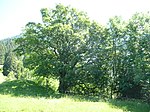
|
three sycamores near the Alpe Ranzenberg | 17th |
Hohenems location |
Blackboard text: Natural monument sycamore (Acer pseudoplatanus)
The sycamore maple is a typical representative of our mixed mountain forests. Thanks to its roots, it consolidates the soil protectively. In addition to the shade in summer, it unfolds its landscape-defining beauty in autumn when it puts on its golden dress. The sycamore seed only germinates after it has been exposed to temperatures around freezing point. This prevents it from germinating too early in autumn and subsequent freezing in the cold winter days. The light, warm maple wood is used in many ways. In the past, the leaves were also used as fodder for sheep and goats. [town of Hohenems ] [The board contains a small graphic: a branch with a leaf and flying fruit] |
2000 | |

|
Schillerallee | 18th |
Hohenems location |
No accompanying board: Schillerallee natural monument
The Schillerallee consists of approx. 200 trees and is approx. 100 years old. It was planted on the flood protection of the Emsbach, the "Dämmle", which was built in the last century and led far out into the then uninhabited Rhine valley. The avenue consists mainly of linden trees in the eastern area. This section also represents the longest avenue of lime trees in the country. In the lower area there are mainly ash and willow species . Various other tree species are also occasionally planted. The Schillerallee has its special charm in every season. [town of Hohenems ] |
2000 | |
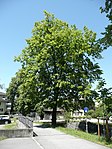
|
Schillerallee | 19th |
Hohenems location |
No accompanying board: Schillerallee natural monument
The Schillerallee consists of approx. 200 trees and is approx. 100 years old. It was planted on the flood protection of the Emsbach, the "Dämmle", which was built in the last century and led far out into the then uninhabited Rhine valley. The avenue consists mainly of linden trees in the eastern area. This section also represents the longest avenue of lime trees in the country. In the lower area there are mainly ash and willow species . Various other tree species are also occasionally planted. The Schillerallee has its special charm in every season. [town of Hohenems ] |
2000 | |

|
Copper beech at the count's palace | 21st |
Hohenems location |
Blackboard text: Natural monument copper beech (Fagus sylvatica)
This copper beech, a variety of the common beech, is one of the mightiest solitary trees in the city center of Hohenems. With a trunk circumference of 303 cm and a height of approx. 25 m, it forms a strongly branched crown. It is estimated to be 120 years old and was planted as a park tree by the count families in the snail garden. European beeches already settled here in the Bronze Age. A beech of this size has around 600,000 leaves annually. With this canopy of leaves, it protects its thin bark from sunlight and temperature fluctuations. [town of Hohenems ] [The board contains a small graphic: a beech leaf] |
2000 | |
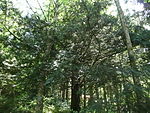
|
Yew tree in Steckenwege | 187 |
Hohenems location |
No accompanying board : Yew (Taxus baccata) natural monument in Steckenwege
The yew tree in the Steckenwege district can be found on the way to the “book stick”. Once in the open field, it is now hardly visible in the midst of young spruce trees. The yew tree has a trunk diameter of sixty centimeters and a crown radius of seven meters, making it a particularly large and probably very old specimen of this rare tree species. Yew trees were in great demand for centuries because of their extraordinarily elastic and durable wood. The processing of the yew trees into arches, veneers, wheel shafts, etc. led to the decline of the slow-growing tree species. The yew tree in Steckenwegen is the mightiest and oldest yew tree in Hohenems and is also one of the largest examples in Vorarlberg. |
2000 | |
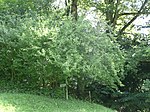
|
Cornelian cherry bush on the Schloßberg | 188 |
Hohenems location |
Table text: Natural monument Cornelian cherry (Cornus mas)
Despite its inconspicuous size and inconspicuousness, the cornel cherry bush is a rarity in the wild. It unfolds its splendor in the end of winter when it covers itself with its yellow flowers. Due to the favorable location on this hill of the Schlossberg, this shrub may have survived as a relic of warmer climates. Other well-known heat-loving plants that have found refuge on the steep slopes of the Schlossberg are the sessile oak . [stadthohenems] [The board contains a small graphic: branches with leaves, fruits and flowers] |
2000 | |

|
Pedunculate oak on Hasenfeldstrasse | 5 |
Lustenau location |
Board text: Pedunculate oak natural monument in the hare field (Quercus robur L.)
This mighty oak tree, more than 100 years old, with a trunk circumference of more than 3 m, is one of the most important street trees in Lustenau. Despite the widening of the Hasenfeldstrasse in the 1970s and the piping of the "Aubächles" that ran down between the tree and the road from the Upper Aue, the oak has a beautiful crown structure with full foliage. [The board contains a small graphic: leaves and fruits] |
||

|
White pasture in the Lustenauer Ried | 6th |
Lustenau KG: Lustenau GrStNr: 4614 location |
The silver willow in the Upper Heuried was declared a natural monument in 1975. In 1992 the trunk diameter was given as 4 m, in 2013 it was already 6.6 m and is probably the strongest tree in Lustenau. In 2008 the tree, which was almost 100 years old at the time, was renovated and the crown was shortened by around 40%. | 1975 | |
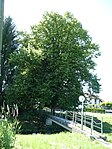
|
Winter linden tree at the Wäldersteig (Neuner) | 182 |
Lustenau KG: Lustenau GrStNr: 6940/1 location |
The winter linden tree on the Wäldersteig is a particularly striking element of the bank planting of the Lustenau Canal . The 25 m high tree can still be seen from a great distance from the direction of the Swiss reed to the east, so it was declared a natural monument in 1992. | 1992 |
Former natural monuments
| photo | Surname | ID | Location | description
|
surface | date |
|---|---|---|---|---|---|---|

|
Pedunculate oak stalden | 4th |
Lustenau , Staldenstraße 5 KG: Lustenau GrStNr: 52/3 location |
The English oak was planted in 1868 when it was 3 years old. On October 1, 1944, the tree with a height of 20 m, a trunk circumference of 3.15 m and a crown diameter of 17 m was declared a natural monument. The root was probably damaged during road construction work in the 1950s or 1960s, which triggered a fungal infestation with the bulging Lackporling . Due to the continuously progressing white rot , the privately owned tree fell lengthways on the morning of April 7, 2014 into the street and had to be secured and removed by the fire department. At this point in time the stalden oak was 22 m high, the trunk circumference was 4.70 m and the crown diameter was 12 m. The Lustenau-Kirchdorf Middle School received a stem disk with a diameter of more than one meter for natural history and history lessons. | 10/01/1944 |
| Photo: | Photography of the natural monument. Click the photo generates an enlarged view. There are also two symbols:
|
||||
| Surname: | Designation of the natural monument according to official sources | ||||
| ID | Identifier | ||||
| Location: | The municipality and, if available, the address are given. The cadastral community (KG) and the property number are listed below. By calling up the link Location , the location of the monument is displayed in various map projects. | ||||
| description | Brief description of the natural monument | ||||
| surface | Area of the natural monument in hectares (ha) | ||||
| date | Date or year of protection |
literature
- Office of the Vorarlberg state government, Department IVe - Environmental Protection: List of natural monuments. (without geotopes)
- Walter Krieg, Rudolf Alge: Vorarlberger natural monuments. Hecht Verlag, Hard 1991, ISBN 3-85430-151-0 .
- Cornelia Peter: Natural monuments in Hohenems and the local protected area »Schollaschopf«. In: emser almanac. no.3, 2nd year 2001, pp. 5–15, published by Kulturkreis Hohenems.
Web links
- Natural monuments. at: Hohenems.at/de
Individual evidence
- ↑ a b c d e after war / Alge: Vorarlberger Naturdenkmale ; see references
- ↑ a b c Cornelia Peter: Natural monuments in Hohenems and the local protected area »Schollaschopf« ; see references
- ↑ Lustenau active . In: Marktgemeinde Lustenau (Ed.): Lustenauer Gemeindeblatt . No. 34 , 2013, p. 2 ( lustenau.at [accessed on April 29, 2014]).
- ↑ Lustenau active . In: Marktgemeinde Lustenau (Ed.): Lustenauer Gemeindeblatt . No. 32 , 2013, p. 2 ( lustenau.at [accessed on April 29, 2014]).
- ↑ Wolfgang Scheffknecht: 100 years market town Lustenau . Lustenau 2003, ISBN 3-900954-06-2 , pp. 395 f .
- ↑ Staldeneiche leaves a gap in the townscape . In: Marktgemeinde Lustenau (Ed.): Lustenauer Gemeindeblatt . No. 16 , 2014, p. 17 ( lustenau.at [accessed April 19, 2014]).